Category: General

Sony and Honda’s Afeela 1 electric hatchback arriving in 2026 for $89,900
- The Afeela 1, the EV from a joint venture between Honda and Sony, will arrive in 2026
- Base Afeela 1 EVs will cost $89,900 while the Signature trim costs $102,900
- Afeela is now taking $200 deposits, but it’ll only be available in California initially
Sony and Honda confirmed pricing for the first electric vehicle from their joint Afeela brand at this week’s CES 2025 in Las Vegas.
Now officially known as the Afeela 1, the electric hatchback will cost $89,900 in base Origin spec. A $102,900 Afeela 1 Signature grade is also available, adding 21-inch wheels and a rear-seat entertainment system. The pricier model will also arrive earlier. It’s expected to start deliveries in 2026, while buyers of the Origin will have to wait until 2027.
Afeela is now accepting reservations, requiring a $200 refundable deposit, but only in California. Another caveat is that software-enabled features such as driver assistance and voice recognition are subscription-based, and only complimentary for the first three years of ownership.
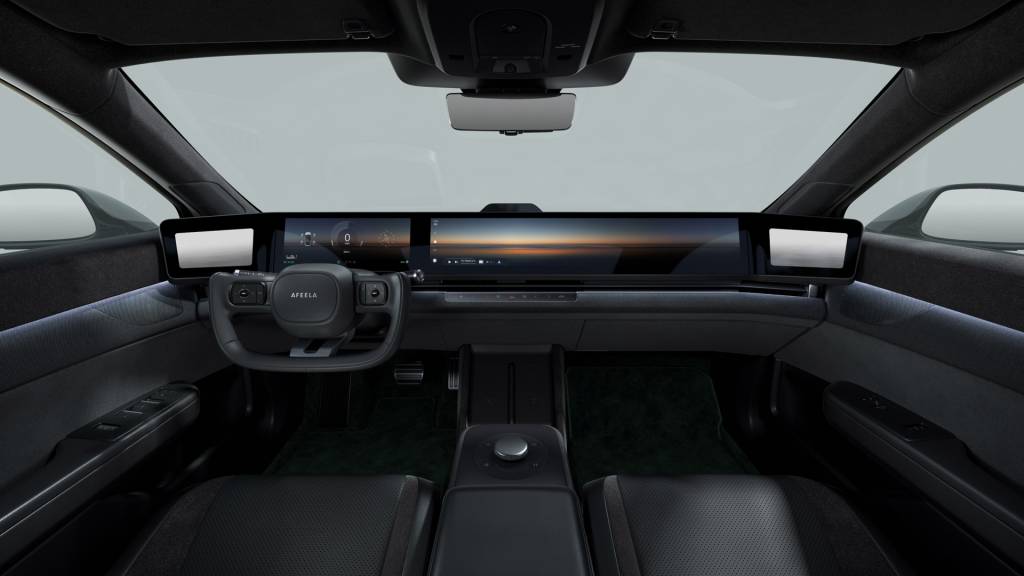
Afeela 1
The near-production ready version shown at CES 2025 looks similar to the prototype shown in 2024, with some changes such as added cameras at the front corners of the roof. They’re part of an array of 40 sensors aimed at enabling Level 3 automation on the SAE autonomy scale. This allows for eyes-off driving in some situations, but Afeela expects to only offer Level 2 capability initially, and will ship cars with driver-monitoring systems.
The innocuous looking hatchback measures 193.5 inches long, making it about two inches shorter than a Honda Accord, but with a wheelbase that’s almost seven inches longer. The interior features door-to-door screens and a yoke-style steering wheel to make them easier to view. Afeela also claims that 70% of the interior’s surface area is made from plant-based or recycled materials.
A sophisticated audio system leverages Sony’s 360 Spatial Sound Technologies for 3D sound. This, combined with the many screens, is aimed at making the car into a mobile lounge for watching videos or using apps that Afeela is engaging with third parties to develop. And yes, you can run PlayStation video games on the dashboard screen, as well as get game-inspired wallpapers for both the interior screen and a “media bar” that takes the place of a traditional grille.
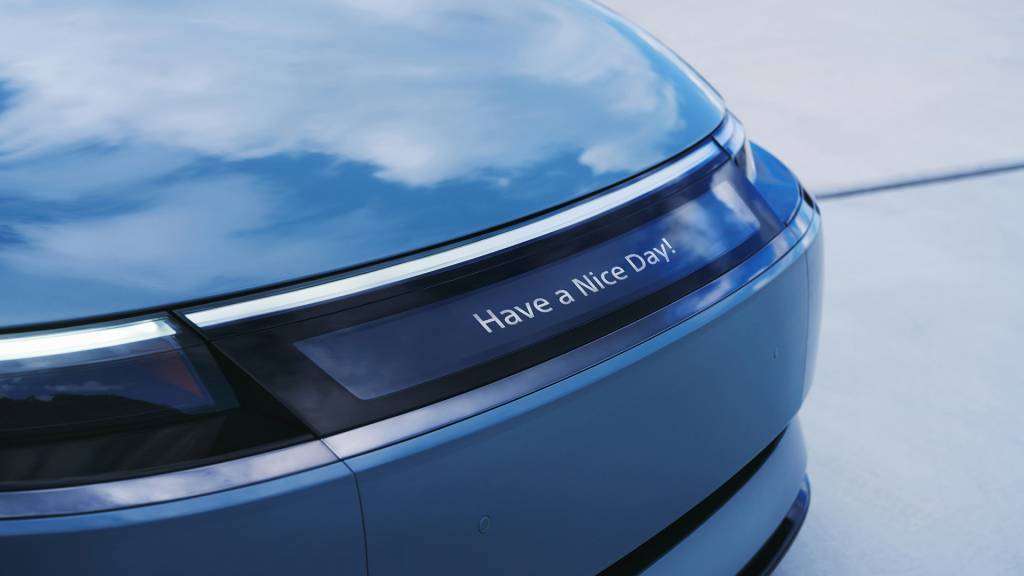
Afeela 1
A standard dual-motor all-wheel-drive powertrain includes one 241-hp motor per axle. Afeela said it’s aiming for 300 miles of EPA range using a 91-kwh battery pack, and will offer NACS charging from the get-go. However, the peak DC fast-charge power rate is a fairly low 150 kw. The Afeela 1 can also charge at 11 kw using a Level 2 AC charger.
Sony’s interest in building an electric car goes back to the Vision S concept presented at CES 2020. It followed that up with the Vision S-02 SUV concept before announcing its partnership with Honda in 2022. The Afeela brand was announced a few months later, at CES 2023.
The Afeela 1 will be built in Ohio, where Honda is expanding two plants to accommodate production of EVs, including its own 0 Series models also due in 2026 and future EVs for the premium Acura brand.

EVs don’t need to charge as quickly as gas cars fill up, US consumers say
- 77% of Americans indicated they’d wait up to 40 minutes for a charge to 80%
- Many current EVs meet that timeframe already
- More consumers prefer dedicated charging stations vs. gas stations with chargers
Long charging times and lack of available public charging stations have been cited as major roadblocks to EV adoption in countless studies and surveys, but a new survey of U.S. consumers conducted by Deloitte indicates that attitudes may be changing.
While it included about 31,000 responses from thirty different countries, the survey found that charge times may be what analysts called a “softening barrier” for U.S. consumers and EV adoption, with many appearing less interested in speeding up EV charging to match gasoline fill-ups. Of U.S. consumer surveyed, 77% said they were willing to wait up to 40 minutes to charge their car from zero to 80%—well within the DC fast-charging envelope of many current EVs.
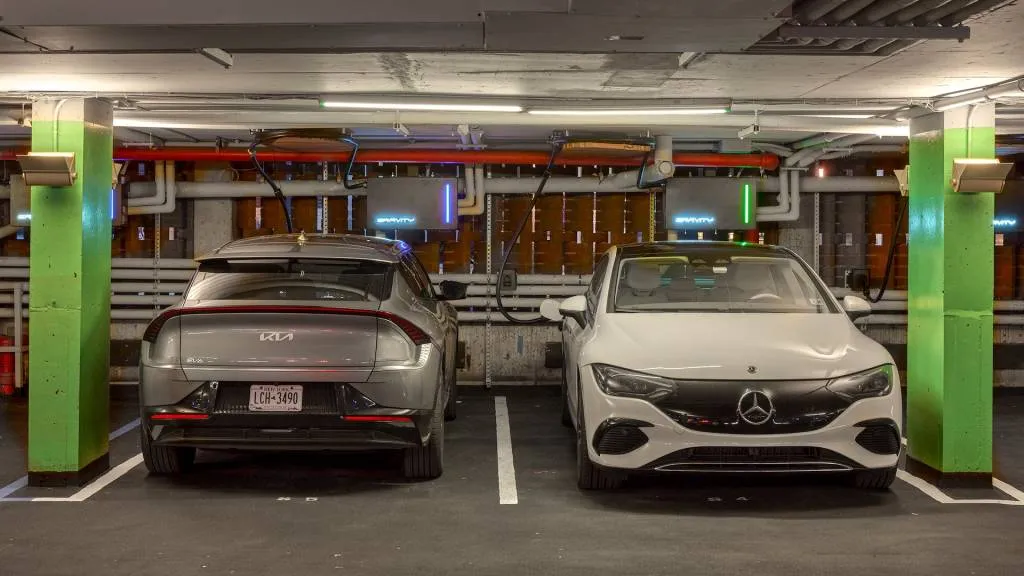
Gravity EV charging center in New York City
While respondents said that fast-charging time was the most important part of the EV charging experience, a majority were able to wait 21-40 minutes for a charge. The location was also important, with 44% of respondents saying they preferred a dedicated EV charging station to a gas station with chargers, while only 15% preferred the opposite.
The study also underscored that many EV drivers don’t require frequent fast charging. Most (79%) of U.S. respondents intending to buy an EV said they planned to charge at home. That’s a figure close to what various studied have found for years—although 58% of the overall survey sample said they do not currently have access to a charger, which begs for more details. And 35% of U.S. consumers surveyed said they drive more than 60 miles from their home only once or twice per month, while a further 23% said they never go that far.
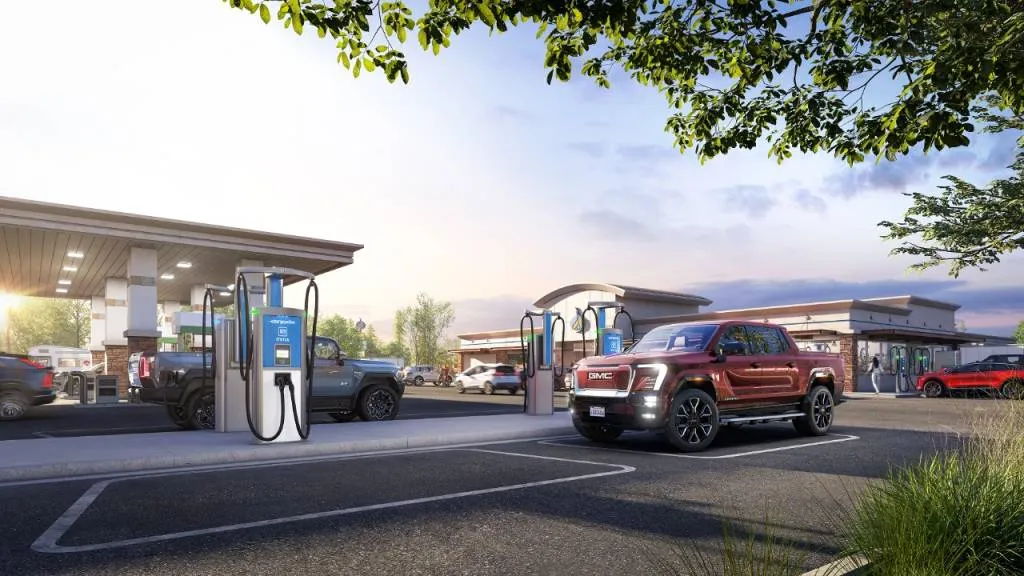
General Motors and ChargePoint EV fast charging
This paints a different picture than a Deloitte study published about a year ago, which concluded that EV charge times and cost could be holding shoppers back. Two years earlier, another Deloitte study found that two-thirds of Americans didn’t want an EV, primarily due to range and cost concerns.
If this study’s conclusions are accurate, though, EVs are set to exceed consumer expectations. The list of vehicles with especially short road-trip charge times is growing, and several companies, including Toyota, have teased that 10-minute charge times may be around the corner—potentially involving solid-state batteries.

Ford sold more electric Mustangs in 2024 than gas-powered ones
The electric Ford Mustang Mach-E SUV outsold its gasoline coupe and convertible siblings in 2024.
Ford recently released its Q4 and year-end sales results, which showed 51,745 Mach-E sales and 44,003 gasoline Mustang sales. Those represented a year over year increase of 26.9% from 2023 for the Mach-E, and a decrease of 9.5% for the gasoline Mustang.
That’s despite the Mustang being the last of the V-8 pony cars after the discontinuation of the Chevrolet Camaro and Dodge Challenger at the end of 2023 (although some leftover inventory remained in 2024) and having its first full calendar year of production following a redesign.
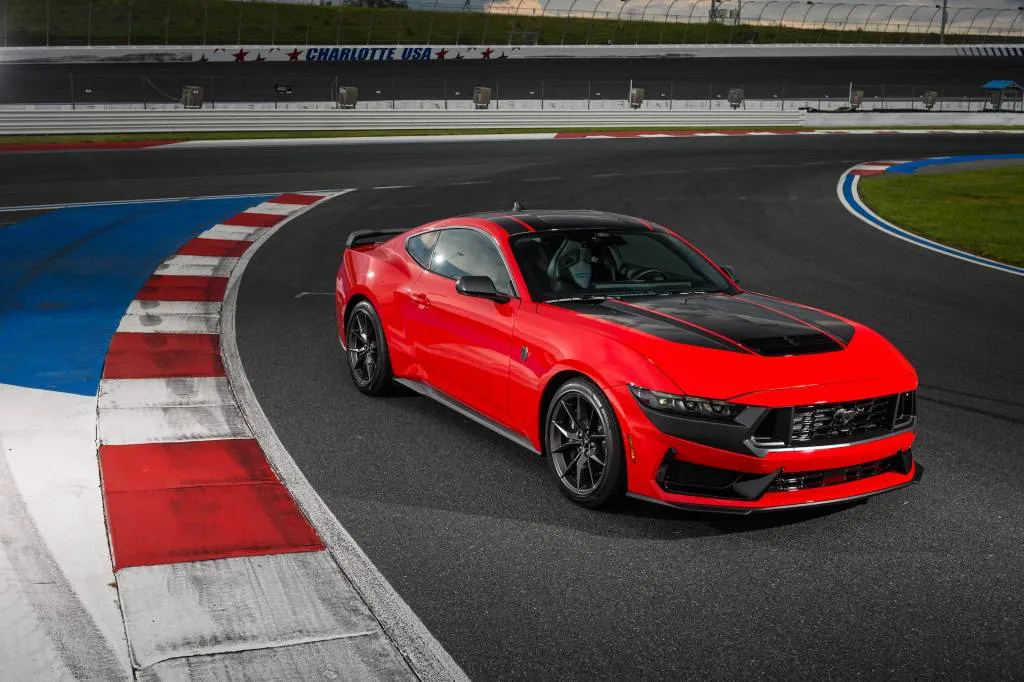
2024 Ford Mustang Dark Horse at Charlotte Motor Speedway, July 2023
Ford pointed to supply chain issues for the Mustang’s 2.3-liter turbo-4 engine, which kept inventory low throughout the second half of the year. This isn’t the first time. In mid-2021, Ford was building more Mach-E EVs than gasoline Mustangs, after reportedly choosing to prioritize the electric model in the midst of a global chip shortage.
The Mach-E has had strong sales from the get-go, though. In April 2021, shortly after its introduction, Ford said the electric SUV was moving quickly off dealer lots—an important metric in the auto industry. Ford also started delivering the Mach-E less than a year after the Tesla Model Y’s arrival, helping to quickly position it as an alternative, and has remained committed to true volume production from the beginning.
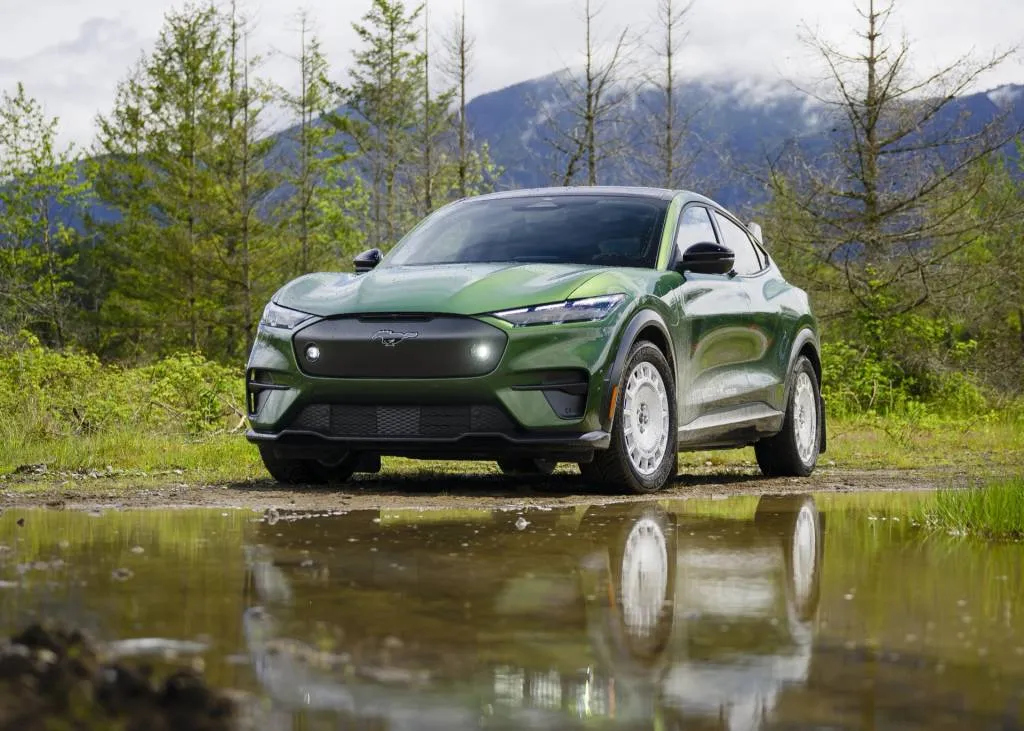
2024 Ford Mustang Mach-E Rally
The Mach-E has also proven itself to be a solid effort. At its introduction, we felt the Ford was better looking and better to drive than the Model Y, which is why we named it Green Car Reports Best Car To Buy 2021. The Mach-E hasn’t been redesigned like its gasoline sibling, but for the 2024 model year it received some updates, including a new Rally grade.
Ford has taken a quite different path with the F-150 Lightning pickup truck, which shares not only a gasoline model’s badge but also its underlying structure. It recently paused production of that model, which managed reasonably good sales earlier in 2024, but remains a small fraction of overall F-150 sales.

Solar-powered Pebble Flow EV travel trailer makes glamping $109,500 affair
- Pebble first showed its Flow electric travel trailer in 2023
- The Pebble Flow is expected to enter production early this year
- The Pebble Flow costs $109,500 and comes with a 45-kwh LFP battery pack
California-based startup Pebble on Monday unveiled a production-intent version of its Flow EV travel trailer, which it hopes to begin delivering to customers in the first half of the year.
First shown in 2023, the Pebble Flow uses a 45-kwh LFP battery pack and self propulsion to assist a tow vehicle, helping to counteract the substantial range loss EVs experience while towing, or the equivalent drop in fuel economy for gasoline and diesel vehicles, the startup claims.
Battery specs are unchanged from what Pebble previously discussed, but the company claims it has made changes to the drivetrain, which can also be used to align the trailer with a tow hitch and even maneuver it in and out of parking spaces using a remote-control function, as part of a smartphone app.
As before, Pebble claims the battery pack can also be used as a backup power source at campsites. It can be charged using conventional AC or DC connectors, as well as an integrated 1.1-kw solar array.
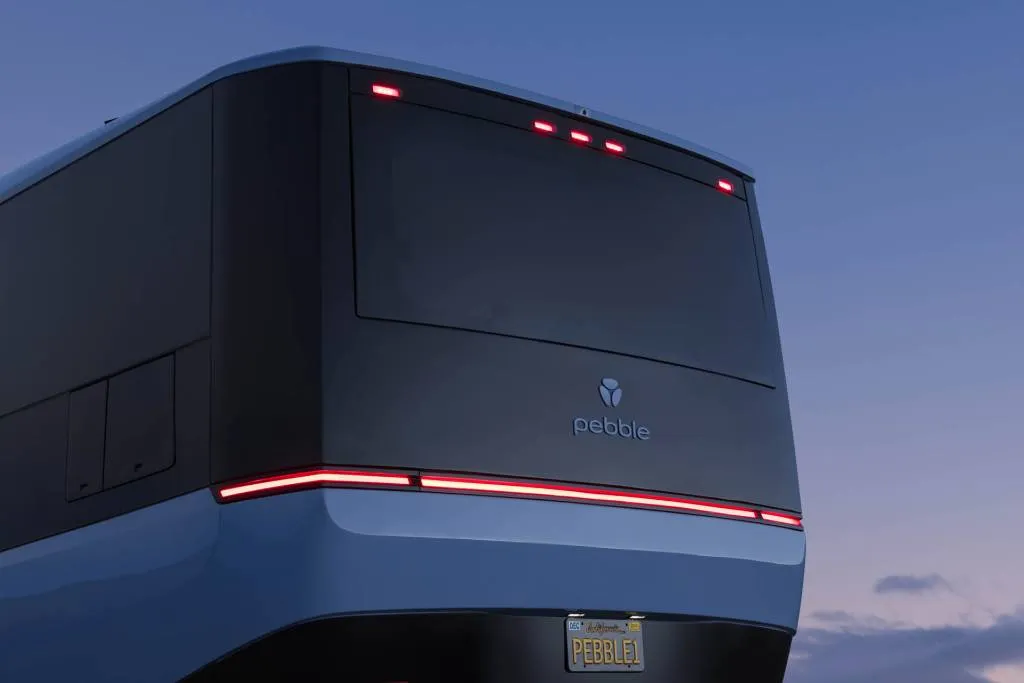
Pebble Flow EV travel trailer
Pebble made some design tweaks, including integrated taillights, aimed at improving both aerodynamics and ground clearance. It also increased the size of the Flow’s pass-through storage space, and added all-terrain levelers and a hitch receiver for accessories like bike racks.

Pebble Flow EV travel trailer
Changes were also made inside, including cabinets that flip up rather than down for easier access, side and rear windows that flip open to increase airflow, a bigger door opening, and increased storage space. A motorized awning has been added as well which, along with lights, stairs, and stabilizers, can be activated at the push of a button.
Pebble expects to begin production early this year, with the first customer deliveries following soon after. Customers can reserve a build slot with a $500 refundable deposit.
The first examples will be Founders Editions with all options included and available limited-edition colors for $175,000. Pebble didn’t break out of the cost of those version, but regular pricing starts at $109,500 for the basic version and $135,500 for a dual-motor version bundling remote control and other tech features.
Pebble isn’t the only startup thinking along these lines. The Lightship AE.1 Cosmos Edition is another travel trailer with a built-in battery pack for supplementary propulsion—and a $250,000 starting price. Airstream unveiled an EV-friendly travel trailer concept in 2023, while Thor Industries—owner of the iconic trailer brand—has proposed a range-extended electric RV as an alternative.
Note — This story was updated with revised pricing from Pebble

2026 Genesis GV60 brings tech updates
- Genesis is giving the GV60 a mild refresh for 2026
- Genesis revealed the updated GV60 globally, but hasn’t detailed specs
- The revamped 2026 GV60 should arrive in the U.S. later this year
The Genesis GV60 is about to receive its first major refresh, which will include a new dashboard display and minimal styling changes.
Genesis revealed the updated GV60 in its home market of South Korea on Monday. Sales are expected to begin in that market later this quarter, and while U.S. launch timing wasn’t discussed, the refreshed GV60 is also expected to land here as a 2026 model.
As hinted at by spy shots of camouflaged prototypes, the styling changes are relatively small. The front fascia is new, while the headlights retain the same shape but receive new internals with smaller LED elements. A new five-spoke 21-inch wheel design will be available, and more exterior trim—such as the wheel arch cladding and the lower part of the rear fascia—is now body color.
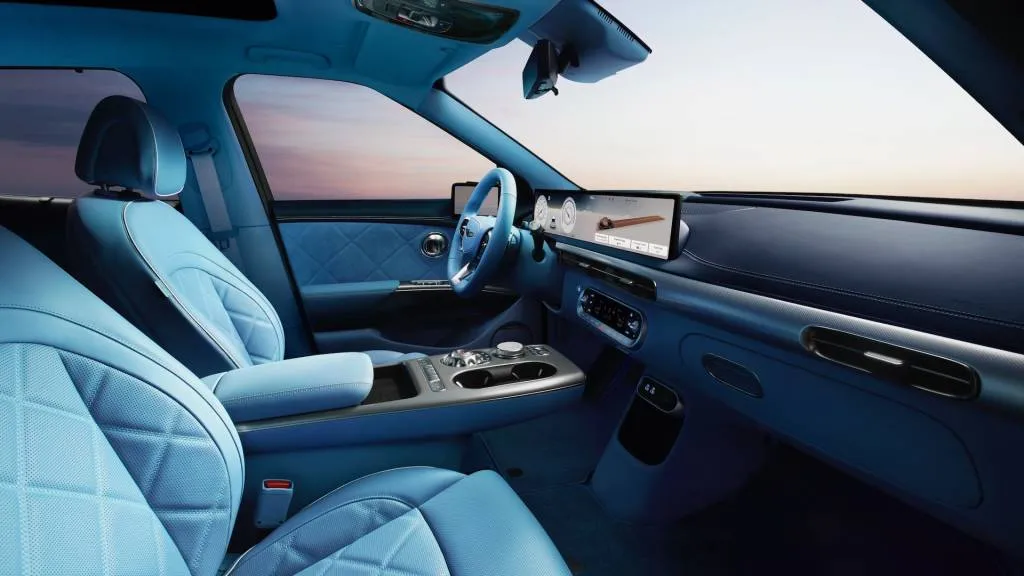
2026 Genesis GV60
Inside, a 27-inch dashboard display occupies the same real estate as the previous interface, but Genesis eliminated the bezel that previously separated the instrument cluster and touchscreen elements. Other aspects of the imaginatively-designed cabin, such as the crystal-orb shifter, remain.
Genesis did not discuss specifications, but a bigger change may come in the form of an 84-kwh pack, replacing the 77-kwh pack currently used in single-motor rear-wheel-drive models and the 77.4-kwh pack used in dual-motor all-wheel-drive models. The bigger pack has already been implemented in the Hyundai Ioniq 5 and Kia EV6, which share the GV60’s E-GMP platform.
Also unannounced at this time, but expected as part of the GV60’s refresh, is a Magma performance model, the first of a new sub-brand competing against the likes of BMW M and Mercedes-AMG. Genesis showed a GV60 Magma concept at the 2024 New York auto show, and confirmed a production version later in the year.
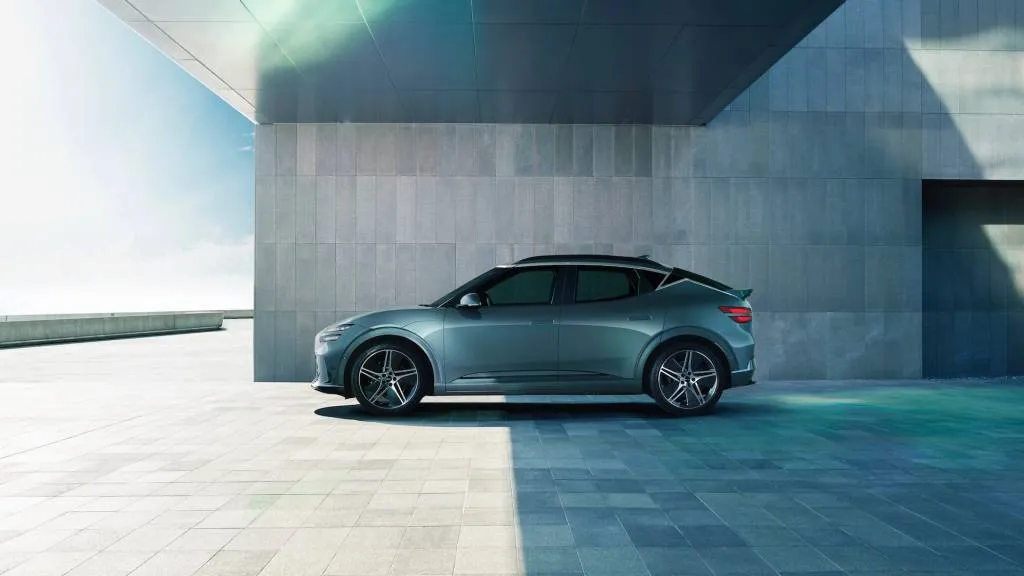
2026 Genesis GV60
The Magma will likely surpass the 429-hp output of the current GV60 Performance. Genesis also offers a non-Performance all-wheel-drive variant rated at 314 hp. Rear-wheel drive models are rated at 225 hp, but offer the most EPA range of any current GV60 configuration, at 294 miles.
The GV60 arrived in the U.S. as a 2023 model and was a Green Car Reports Best Car To Buy 2023 finalist. The rear-wheel-drive powertrain was introduced for 2024, followed by a less-expensive all-wheel-drive version for 2025. Outside the U.S., the GV60 was also the first EV to offer wireless charging, although it’s unclear if that feature will make it here.

Porsche has been developing in-wheel electric motors since 1900
Porsche built its reputation with internal-combustion sports cars, but at the turn of the 20th century Ferdinand Porsche, whose son Ferry would later start the sports-car brand, tinkered with electric motors—including in-wheel hub motors.
The first electric-vehicle boom occurred at the turn of the 20th century, before internal combustion established itself as the dominant technology. And on Apr. 4, 1900, an EV that the then 24-year-old Porsche helped develop was unveiled at the Paris World’s Fair.
Having previously a complete electric car in 1898, Porsche designed electric motors to be integrated with the front hubs of a vehicle built by the Austrian firm of Jason Lohner & Co. in a period of only 10 weeks. Each motor generated 2.4 hp, which got the vehicle, known as a Lohner-Porsche, up to a top speed of 19.8 mph. Besides the motors, another notable innovation of the Lohner-Porsche was four-wheel braking—a rarity at the time.
Working with Ludwig Lohner, Porsche continued to develop hub motors, creating three sizes with outputs up to 11.8 hp for use in trucks and buses as well as passenger cars. These motors were intended for use with lead-acid batteries—typical of the time—that provided a claimed range of up to 31 miles.
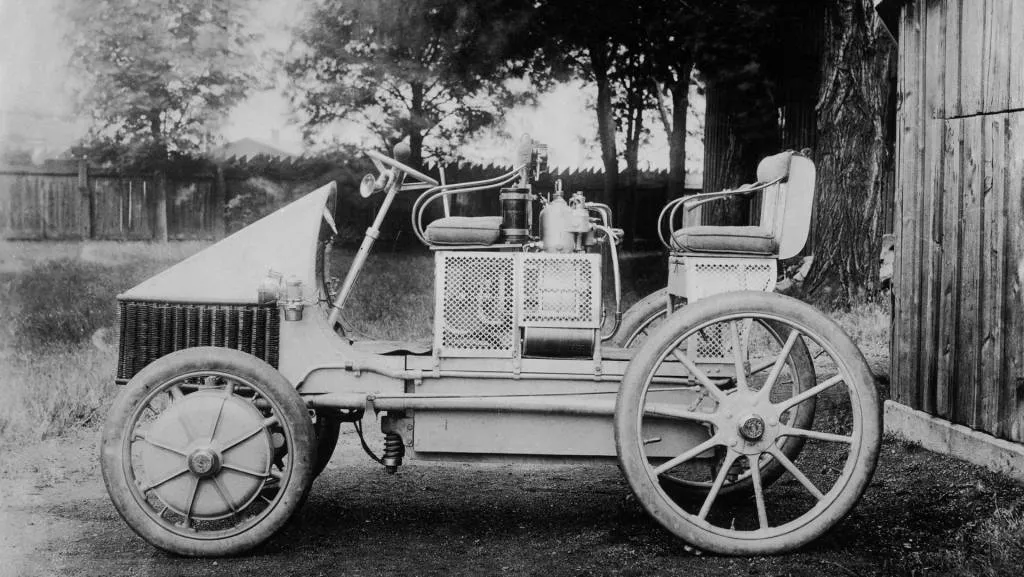
Lohner-Porsche Semper Vivus hybrid
Porsche also designed an all-wheel drive electric race car named La Toujours Contente (French for “the one who’s always happy”), with one 13.8-hp motor powering each wheel. But the engineer’s hub motors saw the most use in hybrids—starting with the Lohner-Porsche Semper Vivus (Latin for “always alive”), which combined front hub motors with a gasoline engine.
Lohner and Porsche eventually applied the same hybrid layout to about 300 production vehicles, including 40 for the Viennese fire department, as well as assorted taxis and private passenger cars.
More than a century later, in-wheel motors are still attracting interest, although adoption for production vehicles has been slow. Chinese automaker Dongfeng claimed to be the first to use them in a fully-homologated passenger car in 2023, although they were also intended for the Lightyear 0 and Lordstown Endurance before production of both vehicle stalled.
Aptera is also including hub motors in what it claims will be a super-efficient 3-wheeler, and patent filings from Ferrari, Hyundai, and Toyota indicate they’re being studied by established automakers as well.

VW ID.4 set to resume sales, production with door-handle fix
- Leaky door handles halted ID.4 production and deliveries in September
- With replacement parts ready, VW is soon restarting production
- Fixing customer cars and dealer stock is the priority
Volkswagen on Friday reported some disappointing U.S. delivery numbers for the year for what had been set to be its mass-market electric vehicle. It sold 17,021 ID.4 EVs in the U.S. in 2024—down 55% versus 37,789 sales in 2023.
Partly, the issue was simply that the ID.4 lineup wasn’t on sale for much of the year—first with a pause as refreshed 2024 models rolled in, then with a recall that stopped production and deliveries.
VW also on Friday confirmed that the ID.4 is back on track. It has enough replacement door handle hardware to restart deliveries of its ID.4 and fix a backlog of vehicles in dealer stock—and, within the next few weeks, to resume production at its U.S. plant in Chattanooga, Tennessee.
VW issued the recall of all 2021-2024 ID.4 models in September, amounting to 98,806 vehicles, as it ramped up a remedy for defective door handles that might cause the EV’s door to open unexpectedly. The recall effort has since been expanded to include 99,064 vehicles in the U.S. plus 20,790 vehicles in Canada.
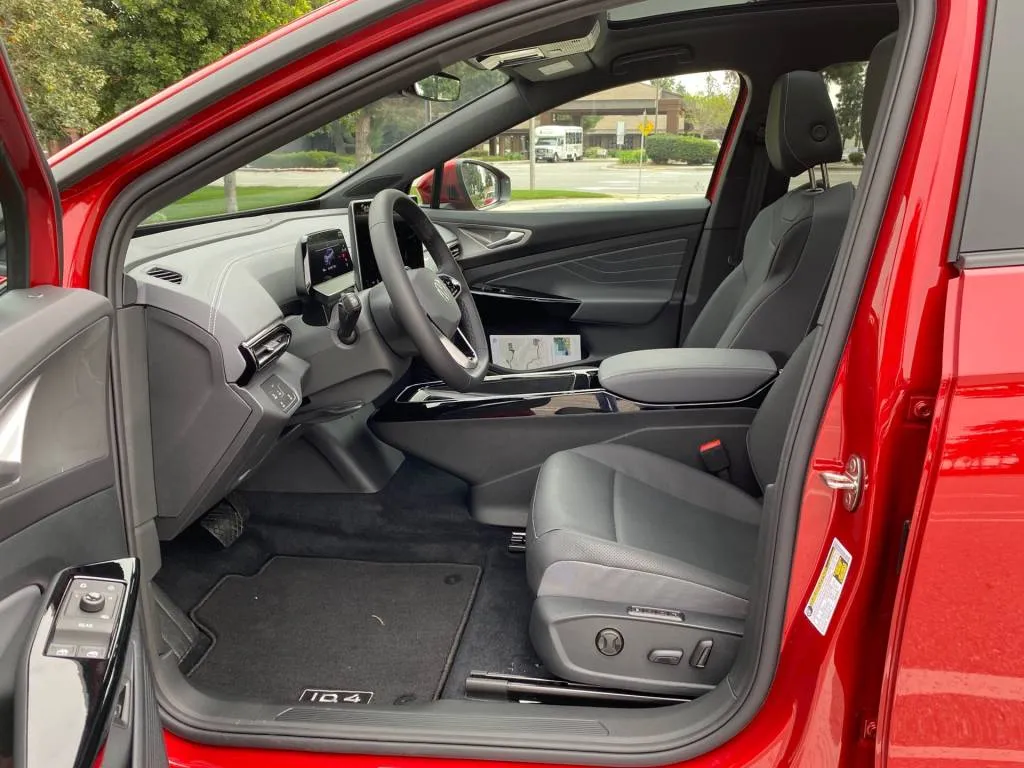
2024 Volkswagen ID.4
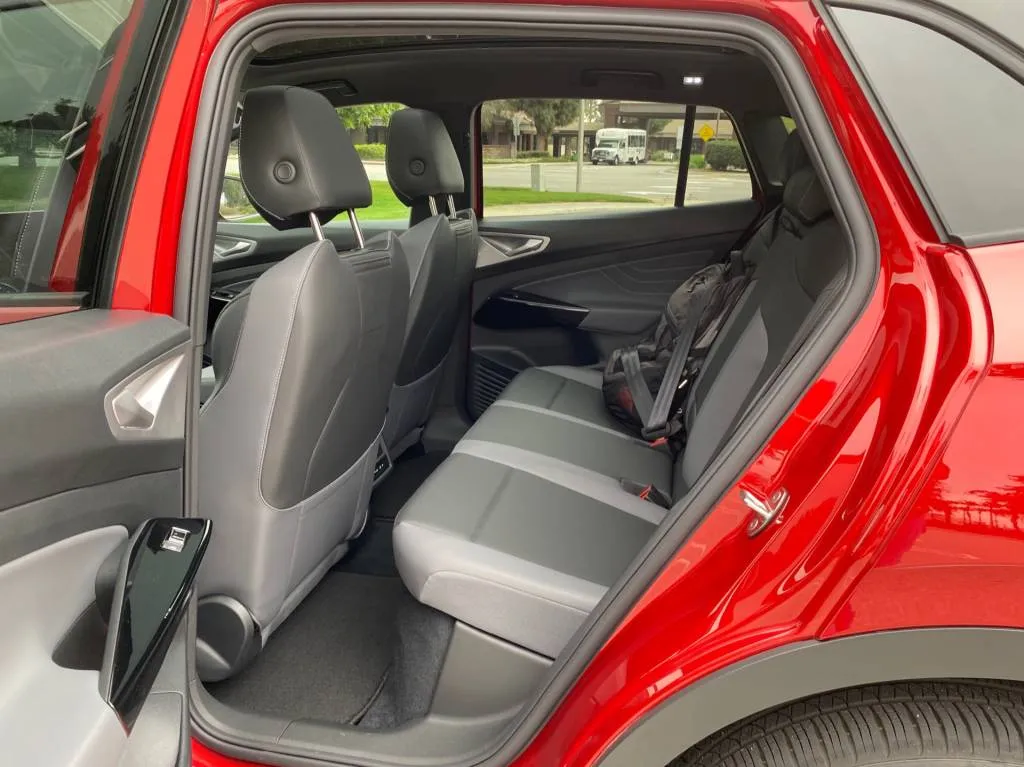
2024 Volkswagen ID.4
At that time, VW also issued a stop-sale for the ID.4, covering both new and pre-owned vehicles in dealer inventory, and it stopped production of the model in both Zwickau, Germany, and Chattanooga, Tennessee.
Concerns focused on the design of the door handle itself, and a part that couldn’t effectively keep out water. According to recall documents filed with the National Highway Traffic Safety Administration (NHTSA), water could enter the door handle, reaching a printed circuit board and causing “communication issues” between the handle and control unit. That might result in a clicking noise that VW said in those documents was similar to what the door makes when it’s normally unlocked.
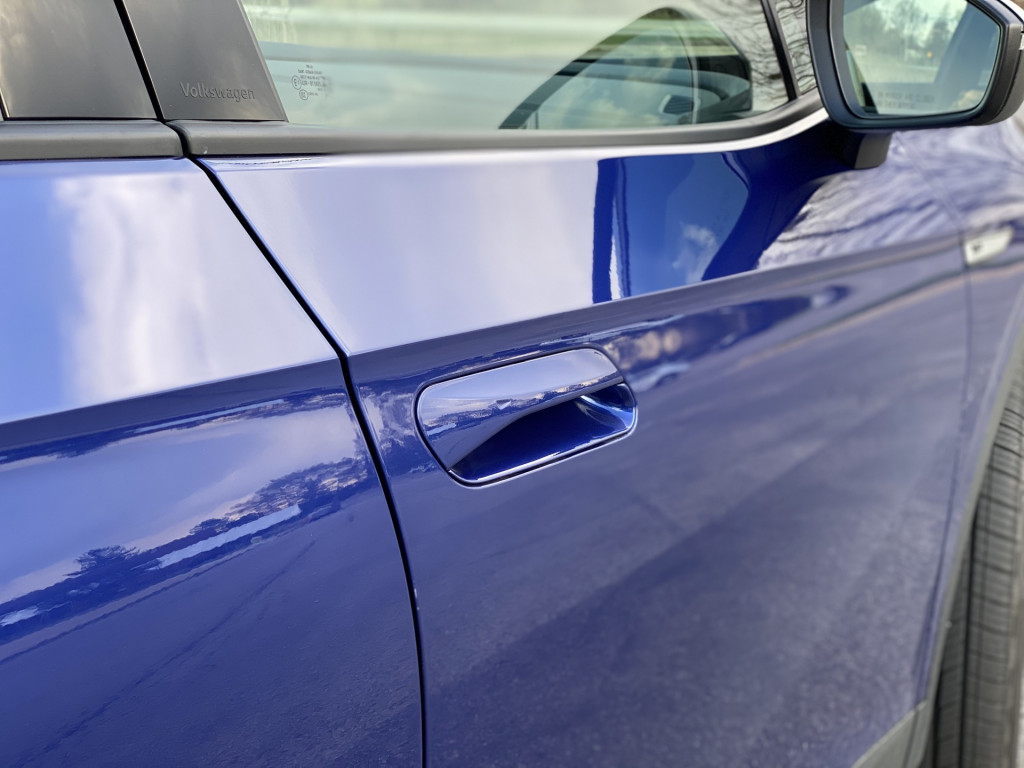
2021 Volkswagen ID.4 1st Edition
VW has already sent letters out to owners, and it’s shipping a redesigned door handle out to dealerships, which will be using them not only to perform the recall fixes but get deliveries of their own stock restarted once again. “The priority is to get existing cars repaired and to get cars that were sitting on dealer lots into the hands of customers,” said Volkswagen spokesperson Mark Gillies.
Under the recall, dealers will inspect and replace the door handles as needed, and update vehicle software. VW stressed that under federal rules, the recall must be completed before delivery.
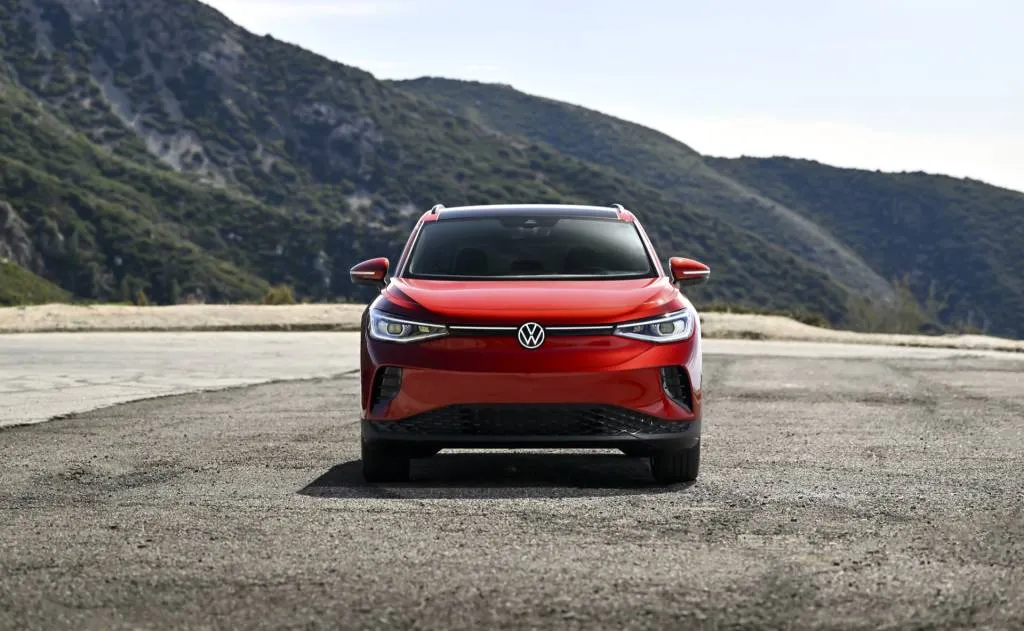
2025 Volkswagen ID.4
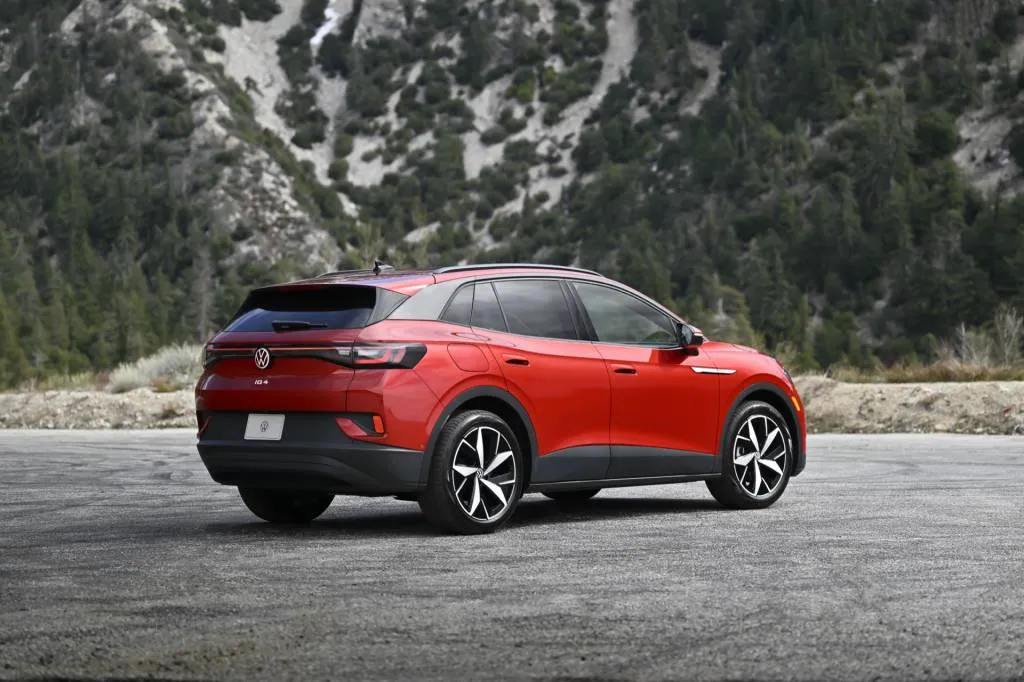
2024 Volkswagen ID.4
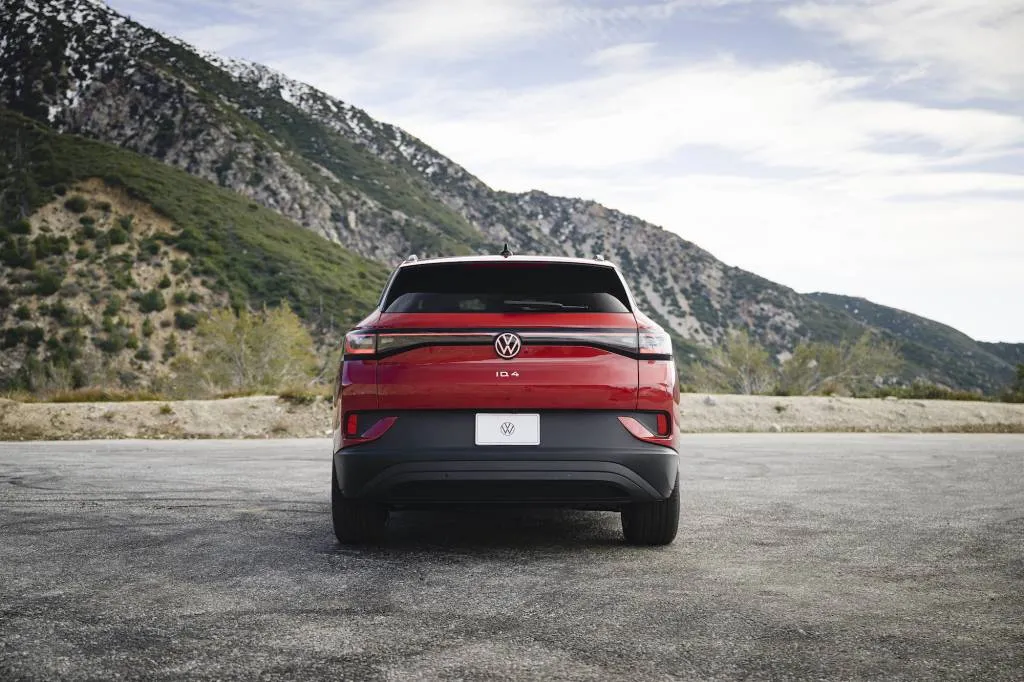
2025 Volkswagen ID.4
The 2024 Volkswagen ID.4 is a top-seller and up until now received a series of meaningful improvements resulting in quicker acceleration and more range, plus speedier new infotainment hardware and a much-improved interface. The interface had especially soured the experience for some early adopters (it recalled 2021-2023 models for those screen issues). Considering the ride, handling, and packaging advantages this model has had all along, the ’24 now feels like what it was supposed to be at launch.
All 2024 VW ID.4 models have qualified for the full $7,500 EV tax credit—bringing the base $41,160 price effectively to $33,660 for some), while the 2025 VW ID.4 has missed the cut, as of yet. But the 2025 ID.4 gets ChatGPT functionality that sets the stage for a next-generation in-car voice assistant.

Future big GM EVs might accelerate charging with multiple connectors
With megawatt charging slow to ramp up, General Motors appears to have an alternative solution to speed up charging for electric commercial vehicles.
This is discussed in a patent filing published by the United States Patent and Trademark Office (USPTO) Nov. 26, 2024, although it was originally filed by GM about two years earlier. In the document, GM notes that medium-duty and heavy-duty electric vehicles require large battery packs that can be time-consuming to charge using conventional methods.
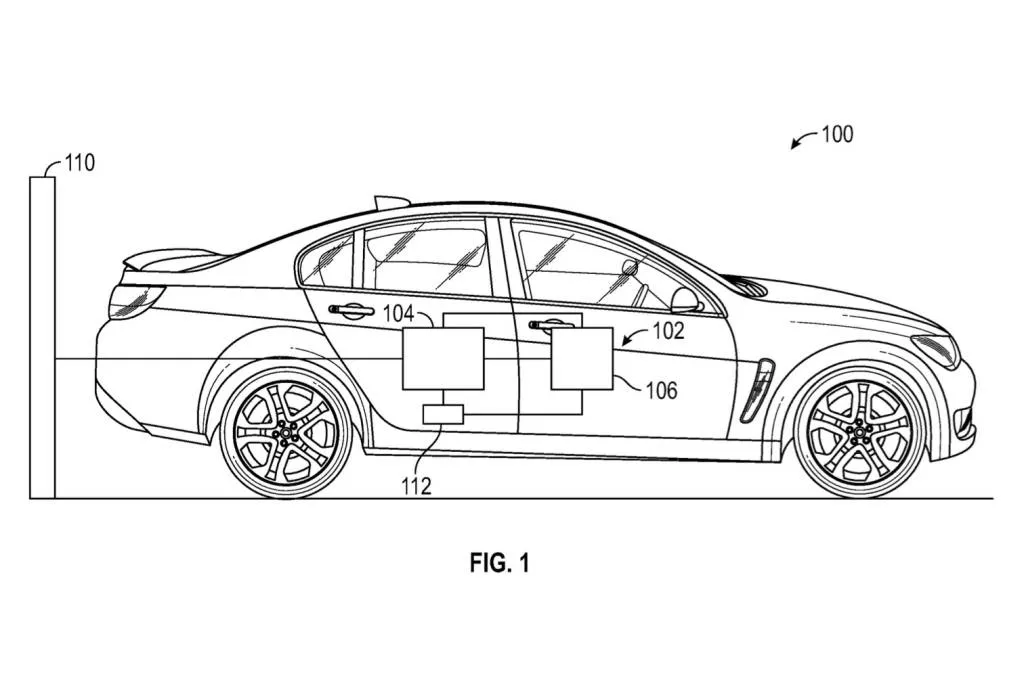
General Motors multi-port charging system patent image
GM’s proposed solution involves equipping vehicles with multiple charge ports and dividing packs into smaller “subpacks” that can be connected in parallel. This allows individual subpacks charged from either a single charge port or both ports simultaneously, instead of charging the entire pack through a single port.
This solution is aimed at larger vehicles that would require bigger packs than the average passenger car (don’t be led astray by the passenger car used in the filing’s example, above), but GM’s inclusion of medium-duty vehicles wouldn’t leave out the GMC Hummer EV or the largest GMC and Chevrolet electric pickups, which do fall into that category based on weight.
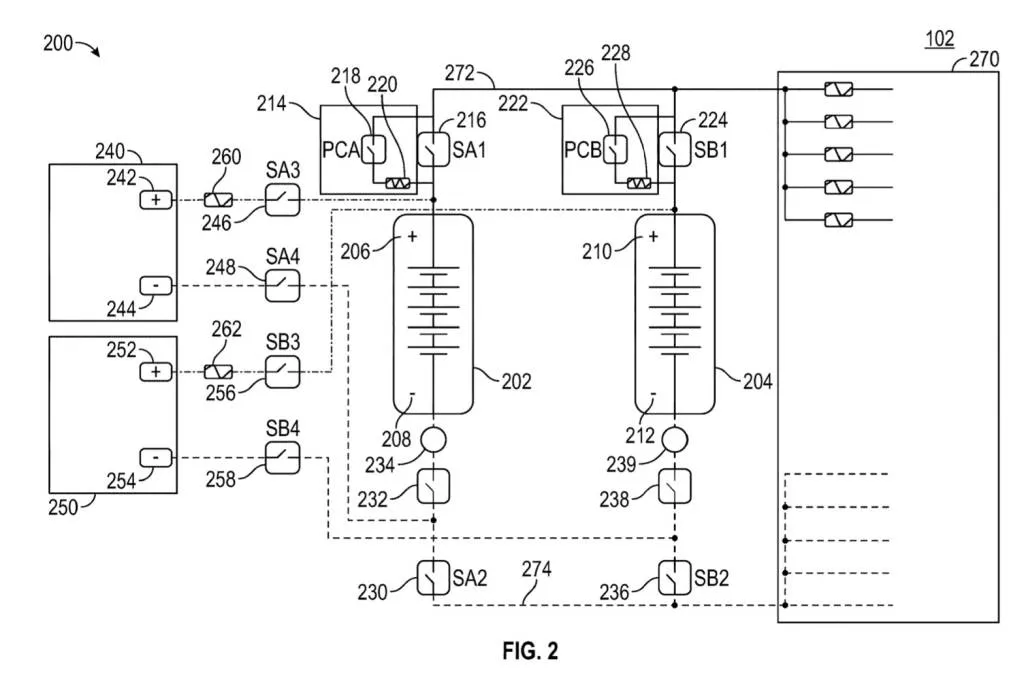
General Motors multi-port charging system patent image
Megawatt charging was announced several years ago as a charging solution for electric big rigs, but it’s been slow to roll out, partly because of the on-the-ground electrical realities. Tesla confirmed megawatt charging for the Cybertruck and Semi, but its Supercharger V4 tech hasn’t truly yet arrived.
We’re already seeing a number of different solutions to speed up charging based on what’s currently available at the connector level. The GMC Hummer EV essentially uses 400-volt battery packs connected in parallel most of the time, albeit with just one charge port. Meanwhile, Porsche splits its 800-volt Macan battery pack into two 400-volt virtual packs to increase charging speed.

Tesla sales fell in 2024
- After many years of gains, Tesla sales and deliveries dropped
- Tesla’s share of the U.S. EV market has fallen below 50%
- U.S. registration figures are yet to come
Tesla sales and deliveries turned downward in 2024, after a seemingly unstoppable trajectory of double-digit gains for many years.
Globally, Tesla delivered about 1,789,226 million vehicles in all of 2024, with production of about 1,773,443 million vehicles. Both of those figures are down versus the reported 1,808,581 deliveries and 1,845,985 vehicles made in 2023.
That’s just over a 1% drop in deliveries in 2024 and a nearly 4% drop in production for the year. And it might have been worse without a rally in the fourth quarter. Tesla noted that it posted a delivery record for Q4, at 495,570 vehicles.
To compare, a year ago Tesla was touting some very different results. Its 2023 deliveries and sales grew 38% and 35%, respectively, over 2022. Tesla’s 2023 sales surge was strong, and its sales numbers exceeded 2022 numbers every single month of the year according to DOE data. That said, China’s BYD continued to edge up on Tesla on the global front in 2023.
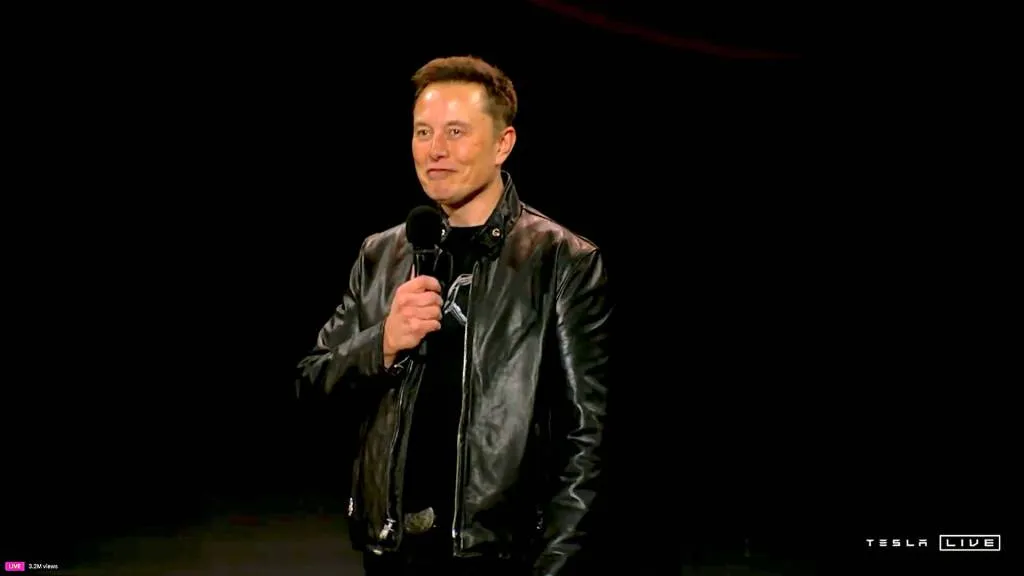
Tesla CEO Elon Musk at Cybercab event (screenshot) – Oct. 2024
In 2023, Tesla CEO Elon Musk became political and by extension so did Tesla in a way it never had been before. By April 2024, reputational studies were showing the relationship, as even more of the American car-buying public connected Tesla with Musk. At this point, it’s hard to ignore an array of consumer-sentiment data points suggesting that the world’s richest man may be getting in the way of Tesla sales growth, especially in California, where it’s held more than a tenth of the new-vehicle market.
Tesla’s share of the EV market shrank in 2023 despite price cuts, to around 50% of the U.S. EV market, and with 2024 EV sales expected to rise overall by about 20% versus 2023, it will certainly lose more of that in 2024. Tesla had continued those price cuts in 2024, with an April move that repositioned the Model Y below the Model 3, thanks to the federal EV tax credit that Musk has backed eliminating.
The Model 3 and Model Y composed the vast majority of Tesla’s global total. Just 94,105 of its global production and 85,133 of its global deliveries were of “other models”—likely including the Model S, Model X, Cybertruck, and Semi.
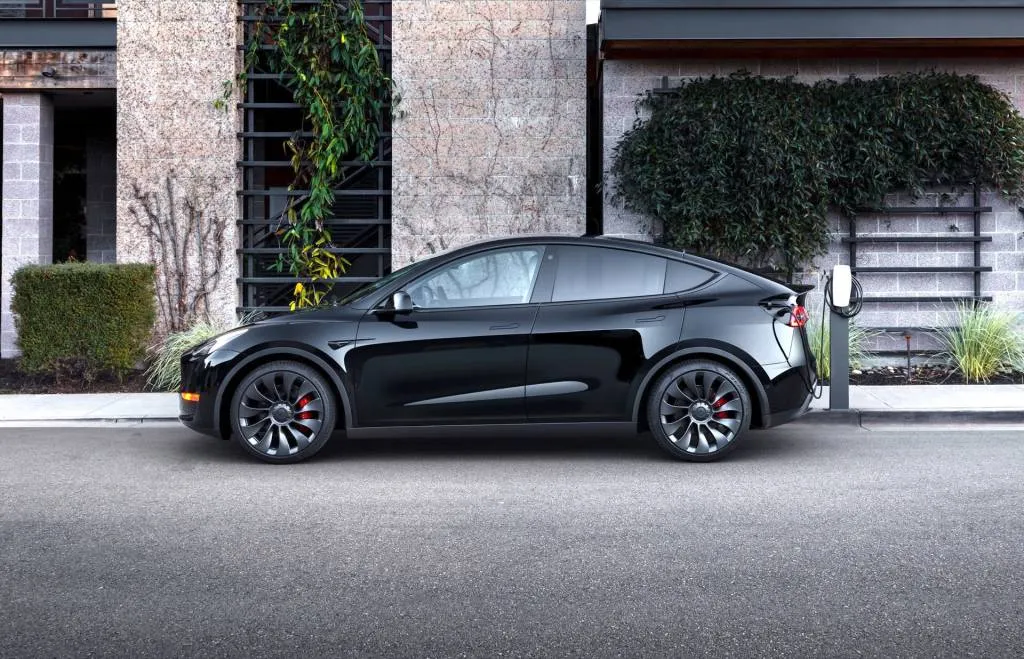
2024 Tesla Model Y. – Courtesy of Tesla, Inc.
As a footnote to this: It’s not yet clear whether Tesla saw sales sputter in the same way in the U.S., looking at the entire year. Through October they were down, however. Citing registration-based figures through that month, Automotive News tallied 499,870 sales through that month, versus 535,834 for the equivalent period in 2023.
Tesla doesn’t report U.S.-market sales figures, which generally rely on state registration numbers and their commensurate lag. But we’ll have an idea on those, and whether Tesla managed to achieve U.S. sales gains for the year, within a few weeks.

Survey: 67% think government should provide EV purchase incentives
- Support for the federal EV tax credit stands at around 50%
- Nearly 80% of EV owners would buy another one without incentives
- Three out of five Americans want state and local EV incentives if Trump kills the federal credit
Even as the Trump Administration is expected to take aim at electric vehicle purchase incentives, they’re actually quite popular with car buyers, according to a new poll published by California-based EV advocacy group Veloz.
The poll, which was conducted by Probolsky Research for Veloz, asked respondents whether the government should provide such EV incentives—and 67% answered in the affirmative. However, that number shrank to 50% when respondents were asked about the federal government specifically.
Adding to the complexity of this picture, 61% of respondents said they wanted state and local governments to “increase their support and invest in electric vehicles” if the federal government ends EV incentives. That’s what California has pledged to do if the Trump Administration nixes the $7,500 federal EV tax credit.
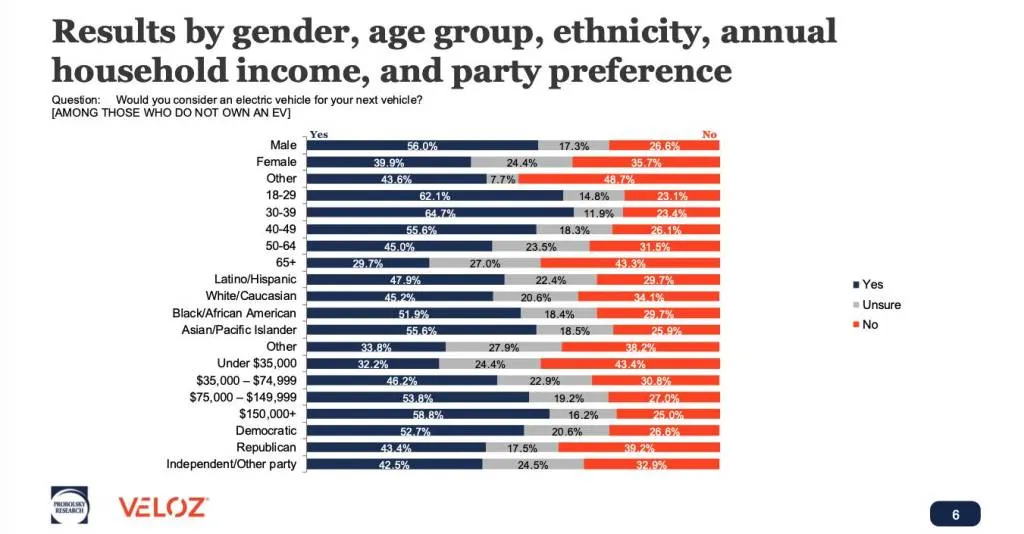
U.S. consumer interest in EVs (from 2024 Veloz poll)
If state and local governments don’t step up and provide this support, EV sales momentum may not be completely halted, the poll indicates. The majority of current EV owners (78.2%) said they would still choose an EV without any incentives that reduce the vehicle’s purchase price, as did 38.1% of non-EV owners.
These results are based on a sample of adult residents of California, Texas, Florida, New York, Pennsylvania (excluding Philadelphia metro), Georgia, Michigan, Washington, Colorado, Hawaii, and Maryland. Veloz and Probolsky Research claim this sample accurately represents the demographic characteristics of each state.
Michigan had one of the lowest rates of those who don’t now own an EV who would consider one. As a post-election report recently suggested, a high-level pro-Trump disinformation campaign (unanswered by Democratic candidate Harris) may have worked very effectively in swaying public opinion—perhaps in a way that sticks beyond the election.
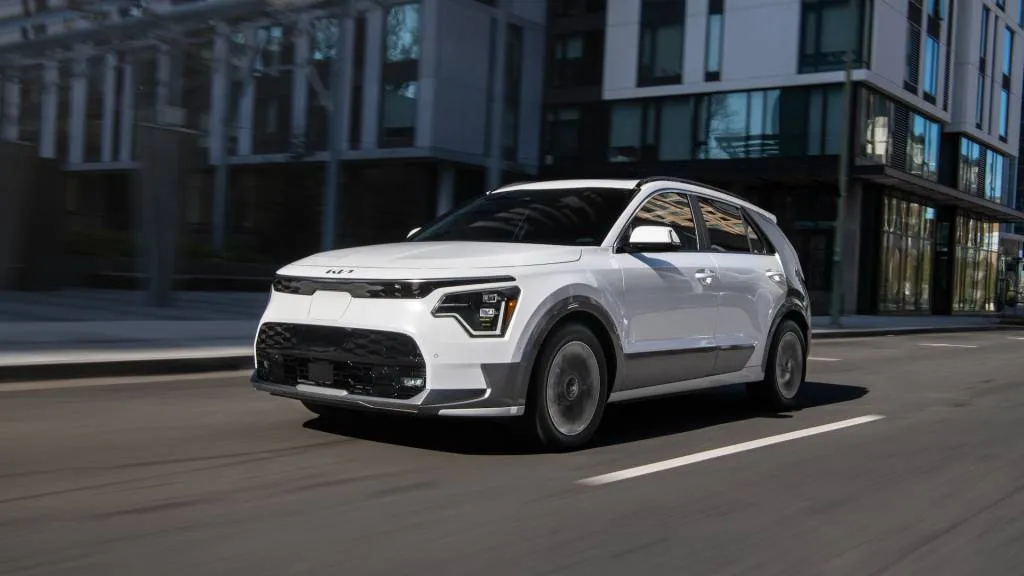
2025 Kia Niro EV
Regarding specific reasons for not choosing an EV, this poll emphasizes, along with so many others before it, that cost is the prohibitive part of EV adoption, with charging and battery concerns coming after that. Nearly half (48.4%) listed the cost to buy an EV as their main concern, with 38.7% citing charging and maintenance costs and 38.3% citing concerns that batteries won’t last long enough.
Yet cost savings were also the top reason for considering an EV. Saving money on gas was the main reason for both EV owners (51.9%) and non-owners (60.3%), followed by improving air quality.
So it seems that sensitivity to cost cuts both ways, with buyers potentially concerned that spending less money on gas will be cancelled out by a high purchase price and charging costs. That’s certainly something incentives could help address.
